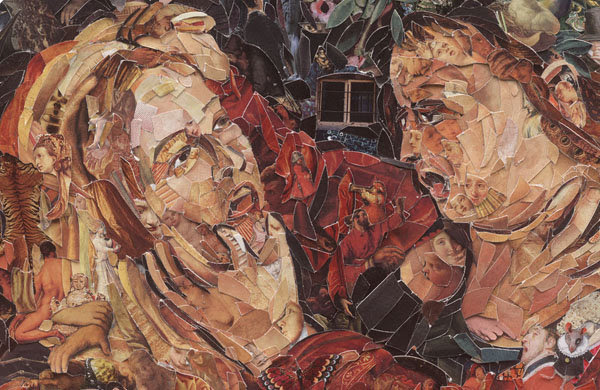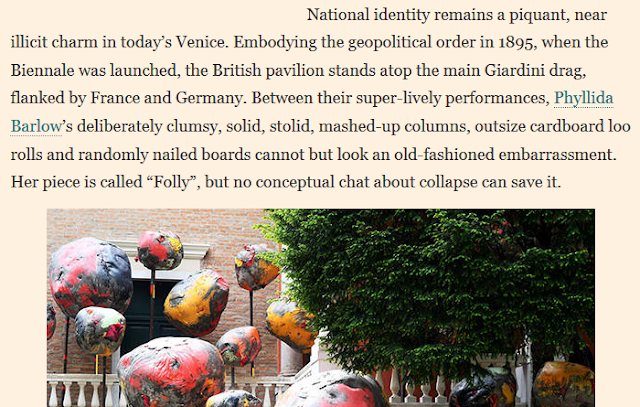Art Night Venezia 2022
Art Night Venezia is taking place on 18th June 2022.
It is an evening of free events around the city. Most of the museums are open for free. There are some events and guided tours which need booking in advance but there's plenty to do without booking. See the website for full details of the programme.
More information (in Italian) at: https://www.artnightvenezia.it
16:35
artnight
Free Museum Entry #domenicalmuseo 2022
Once again in 2022, after the break for Covid, #domenicalmuseo is running every first Sunday of the month with entrance to Italy's state museums free for everyone.
In Venice the museums which take part are:
Full information in Italian: beniculturali.it/domenicalmuseo
In Venice the museums which take part are:
Full information in Italian: beniculturali.it/domenicalmuseo
16:31
museums
The British Pavilion 2017
A collection of videos and articles about this year's British Pavilion.
Phyllida Barlow introduces 'folly'
Join British artist Phyllida Barlow on a tour of her ambitious installation for the British Pavilion at the Biennale Arte 2017 in Venice.The exhibition, entitled 'folly', playfully challenges us to explore our own understanding of sculpture. Commissioned by the British Council, Barlow has transformed everyday materials, such as timber, concrete and fabric, into bold sculptures that infiltrate the entire building, reaching up to the roof and even spilling outside.
Emma Dexter on Phyllida Barlow: folly
Emma Dexter, Commissioner of the British Pavilion and Director Visual Arts at the British Council, explores British artist Phyllida Barlow’s ambitious installation at the Biennale Arte 2017 in Venice.The making of Phyllida Barlow: folly
Discover how British artist Phyllida Barlow created her ambitious installation for the British Pavilion at the Biennale Arte 2017 in Venice.The exhibition, entitled folly, playfully challenges us to explore our own understanding of sculpture. Commissioned by the British Council, Barlow has transformed everyday materials, such as timber, concrete and fabric, into bold sculptures that infiltrate the entire building, reaching up to the roof and even spilling outside.
Bish-bash-bosh: how Phyllida Barlow conquered the art world at 73
This is a lovely article in the Guardian by Charlotte Higgins on Phyllida Barlow's rise to fame.After overlooking her for decades, the art world has woken up to Phyllida Barlow’s audacious, gargantuan sculptures. Now she is representing Britain at the Venice Biennale – but why did it take so long for her to be “discovered”?
And the response the following day, also in the Guardian:
Phyllida Barlow: I couldn't have coped if fame had come 20 years ago
Sculptor who is representing UK at Venice Biennale says she bears no grudge that she spent decades neglected by the art worldPhyllida Barlow: Folly / British Pavilion at Venice Art Biennale 2017
In this video, we have a look at Phyllida Barlow's exhibition “Folly”The Financial Times isn't very complimentary:
But Michael Glover in The Independent seems more impressed:
It is a shame that translating from Italian often causes problems with gender:

Find out more about the exhibition:
British Council website
British Council on Instagram
British Council on Twitter
British Council on Facebook
#BritishPavilion on YouTube
#UKinVenice on YouTube
13:36
biennale
,
exhibitions
Afterglow: Pictures of Ruins


Allegorical Scene after Dosso Dossi, detail © Vik Muniz (2017). Courtesy of Ben Brown Fine Arts, London
Venice, Palazzo Cini
Campo San Vio, Dorsoduro 864
21 April - 24 July 2017
The Palazzo Cini Gallery
The exhibition season opens with the first ever showing of some Vik Muniz photos inspired by old master paintings
On 21 April 2017 Afterglow:Pictures of Ruins will be unveiled. Vik Muniz's latest project has been specially created for the Palazzo Cini Gallery as a homage to masterpieces in the Cini Collection
The 2017 the exhibition season at the Palazzo Cini Gallery at San Vio will get underway with a contemporary art show. From 21 April to 24 July, the second-floor rooms will host Afterglow: Pictures of Ruins, an exhibition by the renowned photographer Vik Muniz. A homage to Venice that grew out of discussions with the curator Luca Massimo Barbero, the Director of the Institute of Art History at the Fondazione Giorgio Cini, the show includes some new photos inspired by great artists in the Cini Collection, such as Francesco Guardi, Dosso Dossi and Canaletto, as well as a very striking glass sculpture.
Thanks to Assicurazioni Generali, the Gallery’s main partner since it reopened in 2014 and for many years an institutional sponsor of the Fondazione Cini, the season of exhibitions open to the public will run until 15 November 2017.
15:41
exhibitions
,
Fondazione Cini
Festa della Salute
 |
| Santa Maria della Salute |
In 1630 the bubonic plague was spreading across Europe. For two years, Venice was ravaged by the outbreak and forty six thousand people were said to have died from a population of one hundred and forty thousand; nearly a third of the population.
Doge Nicolò Contarini made a public vow to erect a church called The Salute, asking for the divine intervention of the Virgin Mary to rid the city of the plague. On October 22, 1630 the Senate decreed that a new church would be built. A competition was held for the design of the church and from the plans submitted by eleven architects, the one by Baldassarre Longhena was chosen. Longhena's design captured both the grandiosity and magnificence that the Serenissima wanted: a church that exalted both the Holy Virgin and the Venetian Republic.
It took until the 1680s for the church to be completed. To give thanks for deliverance from the plague, the Senate visited the church every year. The 21st November is known as the Festa della Madonna della Salute and is still celebrated today in the city. It is one of the most important dates in the year for Venetians.
Every year a pontoon bridge is built across the Grand Canal to connect the San Marco district to the Salute church.
 |
| The bridge of boats |
 |
| One of the 'boats' hold up the votive bridge. |
On the morning of
the 21st November the Patriarch of Venice leads a procession of the city's officials from Saint Mark's Square over the
bridge to the Salute church and the Patriarch gives a service of thanksgiving in the church.
 |
| Venetians entering the church. |
 | ||
| Crowds in the church. |
 |
| The Patriarch's Sermon |
Citizens and visitors then visit the church taking candles to light. There are stalls selling the candles in front of the church.
In the streets behind the church are stalls selling frittelle (doughnuts), balloons, sweets and other food. It can be a crush depending on the time of day.
Castradina, a mutton stew, is typically eaten on this day.
Old Maps, Expeditions and Explorations
Two lovely blog posts about Venice found on the blog "Old Maps, Expeditions and Explorations" by Mitch Williamson
Read more:
Old Maps, Expeditions and Explorations: Venice I
Old Maps, Expeditions and Explorations: Venice II
The first description of these island people comes in a letter sent in 523 to their tribunes by a legate from the Ostrogoth kingdom then prevailing in northern Italy. Cassiodorus was asking them to transport wine and oil across the waters to Ravenna. “For you live like seabirds,” he wrote, “with your homes dispersed, like the Cyclades, across the surface of the water. The solidity of the earth on which they rest is secured only by osier and wattle; yet you do not hesitate to oppose so frail a bulwark to the wildness of the sea.” He was not quite accurate in his description; there were already some houses constructed from the stone and brick of the mainland. He went on to say that the Veneti “have one great wealth—the fish which suffices for you all. Among you there is no difference between rich and poor; your food is the same, your houses are all alike.” Again, this was not quite true. Extant testimonials suggest that, even at an early stage in the development of the lagoon, there were rich as well as poor families. Cassiodorus then added that “your energies are spent on your salt fields; in them indeed lies your prosperity.” In this, at least, he was right. And he added the significant detail of “your boats—which like horses you keep tied up at the doors of your dwellings.” By good fortune one of these boats has emerged from the mud of the lagoon. Part of a rib of oak, and a hull of lime, have been found on the island of S. Francesco del Deserto; the boat itself dates to the fifth century. It was lying at a level that, in this period, would have been submerged except at times of low tide.
Read more:
Old Maps, Expeditions and Explorations: Venice I
Old Maps, Expeditions and Explorations: Venice II
15:26
history
Subscribe to:
Comments
(
Atom
)













